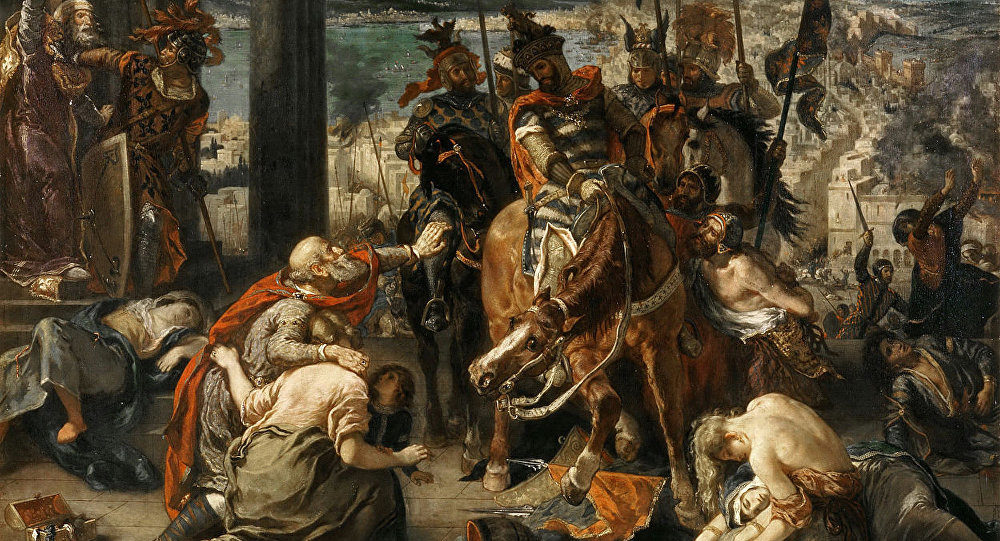
© CC0DNA research adds to evidence soldiers heading east struck up relationships with locals
Crusader armies were made up of people from remarkably genetically diverse backgrounds, hailing not just from western Europe but also much further east, according to a new study that gives unprecedented insight into the fighters' lives.
The Crusades to the Holy Land were spread over two centuries, with many Europeans heading east to fight, and others turning up to trade. While experts say
it is well known that high-ranking crusaders entered into marriages with Armenians to shore up political allegiances, the study adds to evidence that footsoldiers were also striking up relationships as they headed east.
"Those were the regular normal people who are also mixing together, and their sons were joining the fight later on," said Dr Marc Haber, author of the research from the Wellcome Sanger Institute in Cambridge.

© Claude Doumet-Serhal/American Journal of Human GeneticsThe bones found in Sidon.
Dr Kathryn Hurlock of Manchester Metropolitan University, who was not involved in the study, said the findings were not a surprise to historians. "But the popular idea is certainly there was this east v west, Christian v Muslim dynamic with hard lines between the two," she said.
Writing in the American Journal of Human Genetics, researchers in the UK, Lebanon and Belgium report how they extracted DNA from remains believed belong to medieval crusaders. The remains, dating from the 13th century, suggest violent deaths and were found in
a mass burial pit near a crusader castle in Sidon - a coastal port city in what is now Lebanon, but was once part of the crusaders' kingdom of Jerusalem.
They used existing genetic data from modern-day people and a wider range of ancient individuals, as well as newly extracted DNA from local Roman remains, to make comparisons.
The team found all
nine of the medieval individuals from the pit who were analysed were male, but only three hailed from western Europe. Four of the remains were genetically very similar to modern-day Lebanese people, suggesting the men came from the area.The other two men were found to have a mix of European and near east ancestry, suggesting they might have been the offspring of earlier crusaders or other Europeans who travelled to the area to trade and settle. The team say the findings are backed up by an analysis of mitochondrial DNA, and of the men's Y-chromosomes.
Further work helped to shed light on the ancestry of these two men, with
one probably having a parent from what is now Lebanon and another from somewhere in Europe. "The other one is more interesting I think because one of the parents is someone who looks [genetically similar to] Bedouin or Saudi [people], and the second parent is northern Spanish or Basque," said Haber. But, he noted,
"the first Crusades predate [the remains] by about 100 years, so there is plenty of time for them to be second or third generation".The researchers say
the results suggest either the dead from both sides of a battle were buried in the same grave, or that people from the area took up arms to fight with the European soldiers. The evidence, they say, favours the latter. "We suggest they were fighting with them, not against them, because we know from history that the Arab armies that were fighting against the Crusaders came from places like Syria, Turkey, Iraq or Egypt, where the people genetically are different from the near-eastern individuals we found in this pit," said Haber.
The study also revealed that while
the genetics of modern Lebanese Christians show little difference to medieval people from the region, those of modern Lebanese Muslims do show a small difference - something the team put down to the ancestors of the latter mixing more with other populations, including Turks, after the Crusades.The researchers also looked at whether traces of the crusaders could been seen in the genetics of modern Lebanese people, but concluded that any traces they left had been diluted over the generations - something they say highlights the importance of studying ancient DNA.
Prof Jonathan Phillips, from Royal Holloway, University of London, the author of Holy Warriors: A Modern History of the Crusades, said the findings backed up documentary evidence of crusaders and other western Europeans who settled in the crusader states engaging with the local population. "They do use local Christians in their armies," he said, adding that the study countered the "old-fashioned" idea that the crusaders had little to do with the people they encountered. "This really does kill it stone dead," he said.
Comment: Perhaps there's more to the history of the Crusades than is currently known:
- Pilgrims came from afar to 'worship at Moses' last stand' in Jordan
- Witches, Comets and Planetary Cataclysms
- History textbooks contain 700 years of false, fictional and fabricated narratives
- Crusader's Arabic Inscription No Longer Lost in Translation
Also check out SOTT radio's: